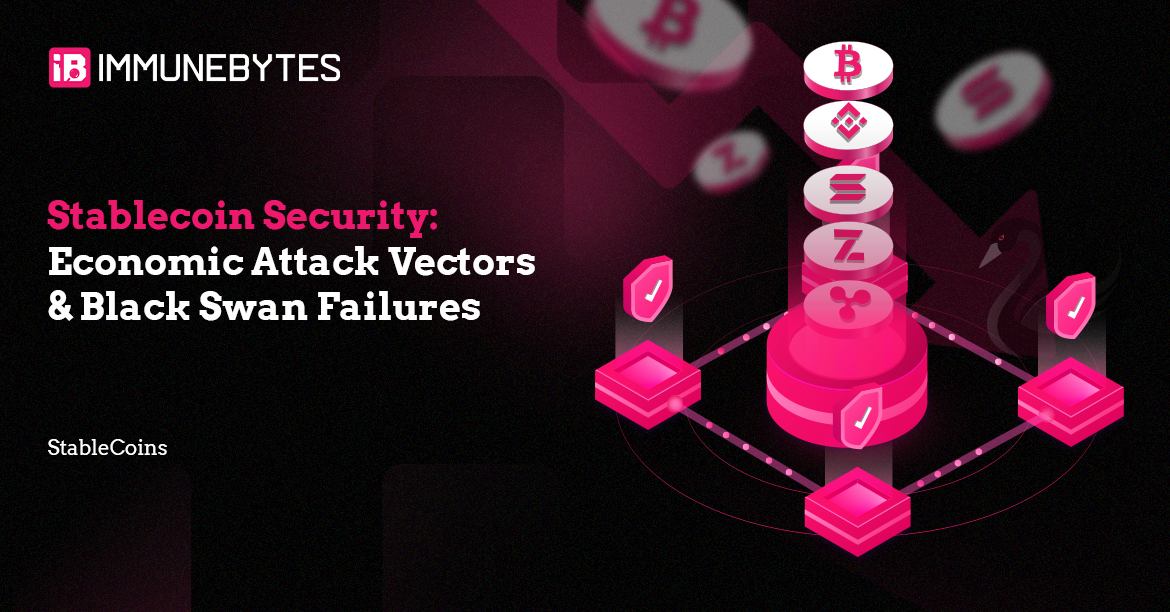Introduction
Stablecoins promise price stability in an otherwise volatile crypto landscape. Pegged usually to fiat currencies like the US dollar, they are a backbone for trading, borrowing, and payments. But this perceived safety is built on fragile systems and economic models, collateral assumptions, and governance structures that can collapse under stress. This article focuses on real failures, including Terra’s economic breakdown and USDC’s brief depegging, to uncover where the real risks lie. The aim is not to criticize these projects with hindsight bias, but to understand what went wrong and what we can learn to avoid similar outcomes.
The TerraUSD Collapse: A Designed Disaster
In May 2022, TerraUSD (UST) collapsed dramatically. At its peak, UST was one of the largest algorithmic stablecoins, relying not on fiat reserves but a mechanism linked to its sister token, LUNA. If UST dropped below $1, users could burn it in exchange for $1 worth of LUNA, theoretically stabilizing its price through arbitrage. The design seemed clever, but it had no actual collateral to back UST, which meant its stability depended entirely on market trust and the value of LUNA.
Compounding this fragility was Anchor Protocol, a DeFi app built on Terra, which offered up to 20% returns for depositing UST. This yield was artificially high and not tied to real revenue. It pulled in billions, but its sustainability depended on continuous new inflows, essentially resembling a Ponzi scheme. When market sentiment turned and users began withdrawing their funds en masse, the mechanism broke. The system tried to print more LUNA to honor redemptions, but that only diluted LUNA’s value, accelerating the collapse. Within days, UST had lost its peg completely, and LUNA’s value dropped to near zero.
The crash wasn’t just a result of bad code or failed economics, it was also about poor risk disclosure, overcentralized governance, and a lack of real-time controls. Terraform Labs had no real plan for a large-scale unwind, and once the bank run started, it became a self-fulfilling prophecy. This was an economic attack vector in its rawest form: exploiting a system that depended entirely on confidence and liquidity without a safety net.
USDC’s Depegging: Real-World Exposure to TradFi Risk
Unlike UST, USD Coin (USDC) is a fiat-collateralized stablecoin managed by Circle. For the most part, it maintained a reputation for reliability and transparency until March 2023, when it briefly dropped to $0.87. This wasn’t caused by a smart contract bug or an algorithmic design flaw. It was caused by the collapse of Silicon Valley Bank (SVB), where Circle had parked $3.3 billion of its reserves.
This incident brought to light a different kind of risk—concentration in traditional finance. While USDC was backed by real dollars, holding such a large chunk with a single institution created a critical single point of failure. When SVB collapsed, uncertainty spread like wildfire, and users rushed to redeem USDC out of fear that those funds might be lost. The peg eventually recovered after federal regulators stepped in and backstopped SVB depositors, but the damage to perception was done.
The Circle did act quickly, they were transparent about their exposure and kept the public informed. But the event still exposed a fundamental risk: fiat-backed stablecoins are only as safe as the institutions where their reserves are held. Crypto might be decentralized, but the moment a stablecoin relies on a bank, it becomes vulnerable to traditional financial failures. This case showed that even “safe” stablecoins aren’t immune to black swan events when their reserves live in legacy systems.
Understanding Economic Attack Vectors in Stablecoins
Stablecoins are vulnerable to more than just coding errors. Many of the most dangerous exploits are economic in nature. One such vector is speculative attack, where bad actors usually with deep pockets exploit weaknesses in peg mechanisms to force a collapse or trigger a profit opportunity. UST’s collapse was arguably an example of this: coordinated withdrawals and sell pressure were enough to unravel the system because the defense mechanisms simply weren’t strong enough.
Liquidity risk is another serious concern. Stablecoins need immediate liquidity to honor redemptions, especially in high-stress scenarios. If a stablecoin holds reserves in less-liquid assets, it risks entering a fire sale or redemption freeze, which only worsens user panic. Moreover, governance vulnerabilities, whether through centralized decision-making or opaque multisig control can be used to manipulate parameters like collateral requirements or redemption logic in ways that hurt users.
There’s also the danger of market manipulation. Entities with enough capital or control can move prices, distort arbitrage paths, or drain liquidity pools. Even in overcollateralized systems, such manipulation can undermine peg trust and create entry points for cascading failures.
What We Can Do: Practical Solutions Over Idealism
The first and most obvious fix is better collateralization. Stablecoins need real, high-quality, liquid assets backing them especially during periods of high volatility. Algorithmic designs need adaptive defenses that can absorb shocks rather than spiral under pressure. No system is perfect, but resilience matters. One way to increase resilience is through dynamic parameters: collateral ratios that adjust based on volatility, or time-weighted redemption logic that slows runs.
Transparency is also key. Regular third-party audits, real-time dashboards of reserve status, and public documentation of risks help build and maintain trust. Circle has done this well post-incident, and it should be a baseline for the entire sector.
Decentralization in governance is another must. Having a protocol’s fate rest on a few insiders makes it easier for malicious or careless decisions to take down the system. Multisig controls, DAO-based updates, and community-based risk management processes can reduce that danger significantly.
Lastly, regulators need to catch up, not to overreach, but to provide a framework that demands operational clarity and reserve integrity. For stablecoins that interface with TradFi, such as USDC or USDT, regulatory guardrails can prevent reserve mismanagement and reduce systemic exposure.
Final Thoughts
The failures of Terra and the brief panic around USDC were not isolated events, they were reminders that stablecoins are still experimental. They’re powerful tools, but they operate at the intersection of economics, technology, and trust. Real-world stress tests, whether from market actors or banking failures, will continue to expose weaknesses. Our job now is to learn from these breakdowns and rebuild smarter, with clearer risk models, better transparency, and more robust designs. Stable doesn’t mean safe by default. It’s something that must be continuously earned.

